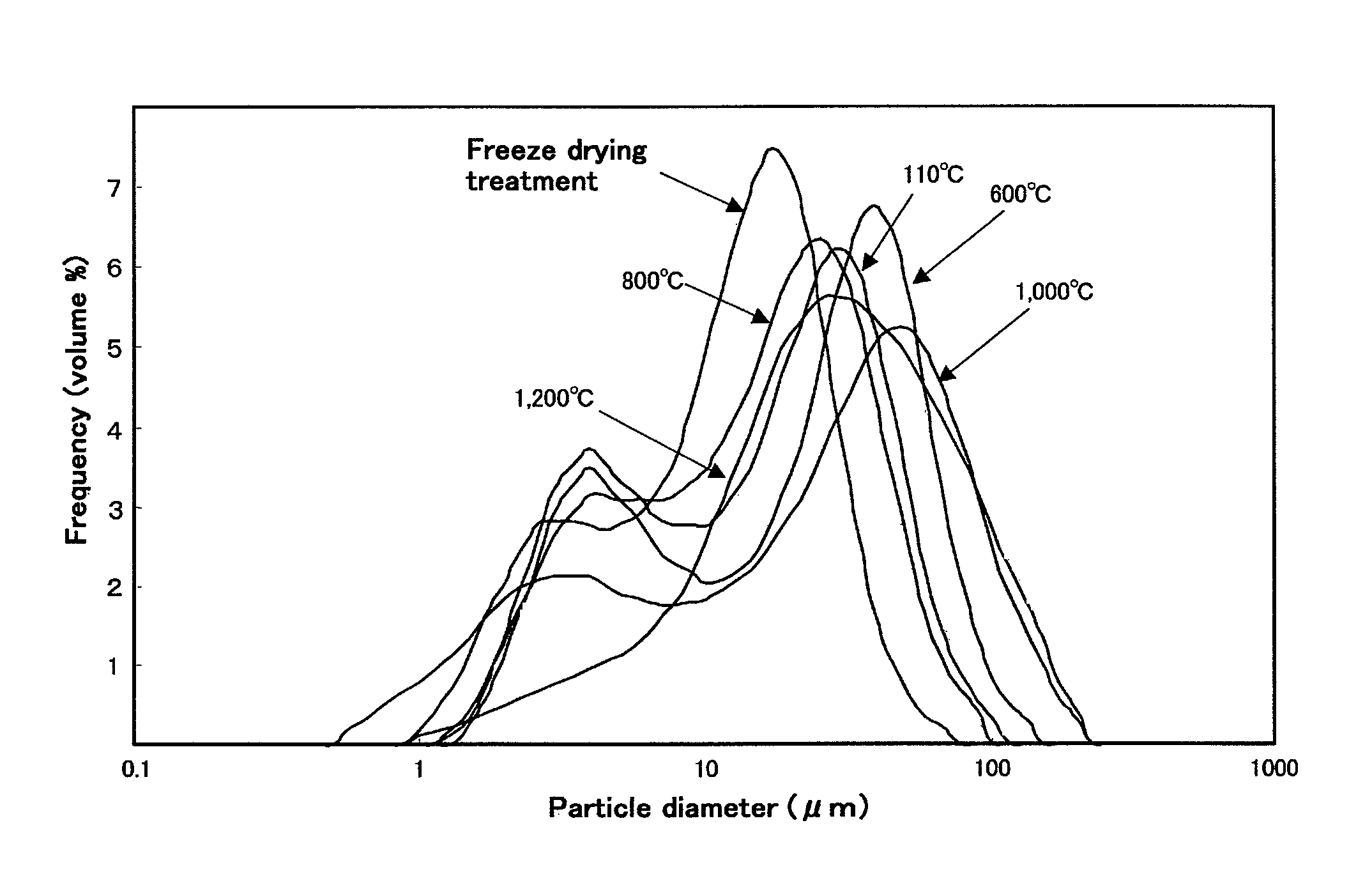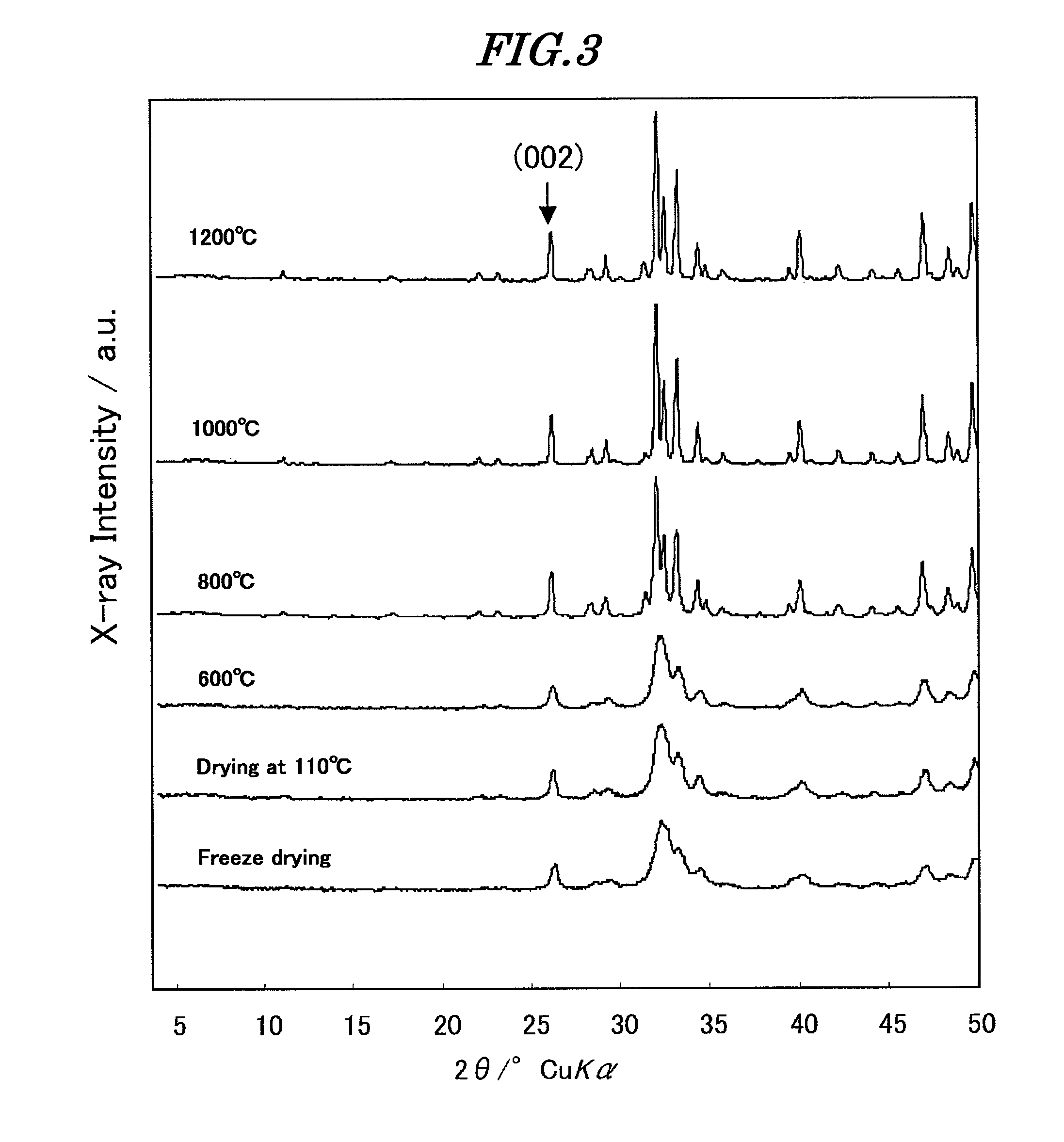Material for cement, and cement
a technology of cement and material, applied in the field of cement material and material, can solve the problems of long hardening period, patient pain, conventional apatite cement, etc., and achieve the effect of easy integration with hard tissues and facilitating new bone developmen
- Summary
- Abstract
- Description
- Claims
- Application Information
AI Technical Summary
Benefits of technology
Problems solved by technology
Method used
Image
Examples
example 1
Investigations Concerning Synthesis Conditions
[0100]For investigating the synthesis conditions, HAp (hydroxyapatite) was synthesized under the experimental conditions shown in Table 1.
[0101]The following five experimental parameters were used:[0102]Synthesis temperature (37, 50, 70° C.);[0103]Rate of stirring (200, 400, 800 rpm);[0104]Reagent concentrations (0.1 M calcium hydroxide and 0.06 M phosphoric acid, 0.5 M calcium hydroxide and 0.3 M phosphoric acid, 1.0 M calcium hydroxide and 0.6 M phosphoric acid, 2.0 M calcium hydroxide and 1.2 M phosphoric acid);[0105]pH adjusting agent (25% NH4OH, 1.5 M NaOH, 1.5 M KOH);[0106]Rate of dropping of phosphoric acid (17, 4.2 ml / min).
[0107]The method of synthesis was specifically as follows.
[0108]First, 500 cm3 of a calcium hydroxide suspension was prepared and 500 cm3 of an aqueous phosphoric acid solution was added dropwise thereto. The concentrations of calcium hydroxide and phosphoric acid were adjusted so that the Ca / P ratio might amou...
example 2
Freeze Dried HAp / IP6 Powder Preparation
[0117]A “freeze dried HAp / IP6 powder” was prepared using the synthesis conditions obtained in Example 1.
[0118]Using the freeze dried HAp / IP6 powder obtained, cement specimens were prepared in the same manner as in Example 1 and measured for compression strength. The results are shown in Table 2.
[0119]The median diameter and particle size distribution of the freeze dried HAp / IP6 powder were measured using the laser diffraction / scattering particle size distribution measurement apparatus LA-300 (product of Horiba Ltd.). The sample was dispersed in purified water and the measurements were made using a flow cell. The median diameter of the freeze dried HAp / IP6 powder is shown in Table 2, and the results of the particle size distribution measurement are shown in FIG. 1.
[0120]The specific surface area (SSA) of the freeze dried HAp powder was measured by the BET method using the Micromeritics automated surface area measuring apparatus FlowSorb III 2305...
example 3
HAp / IP6 Powder Preparation by Drying at 110° C.
[0123]The wet synthesis was carried out in the same manner as in Example 2 and, after maturation, the HAp slurry was recovered by suction filtration, then suspended in 300 cm3 of acetone and again recovered by suction filtration. The recovered HAp slurry was air-dried until disappearance of the acetone and then dried in a dryer set at 110° C. for 2 days. Otherwise the same procedure as in Example 2 was followed to give a “HAp / IP6 powder dried at 110° C.”.
[0124]For the HAp / IP6 powder obtained by drying at 110° C., the median diameter is shown in Table 2, the results of the particle size distribution measurement are shown in FIG. 1, the results of the specific surface area measurement are shown in Table 2 and FIG. 2, the X ray diffraction pattern is shown in FIG. 3, and the half width is shown in Table 2. Using the HAp / IP6 powder obtained by drying at 110° C., cement specimens were prepared in the same manner as in Example 1 and measured ...
PUM
| Property | Measurement | Unit |
|---|---|---|
| specific surface area | aaaaa | aaaaa |
| diameter | aaaaa | aaaaa |
| diameter | aaaaa | aaaaa |
Abstract
Description
Claims
Application Information
 Login to View More
Login to View More - R&D
- Intellectual Property
- Life Sciences
- Materials
- Tech Scout
- Unparalleled Data Quality
- Higher Quality Content
- 60% Fewer Hallucinations
Browse by: Latest US Patents, China's latest patents, Technical Efficacy Thesaurus, Application Domain, Technology Topic, Popular Technical Reports.
© 2025 PatSnap. All rights reserved.Legal|Privacy policy|Modern Slavery Act Transparency Statement|Sitemap|About US| Contact US: help@patsnap.com



